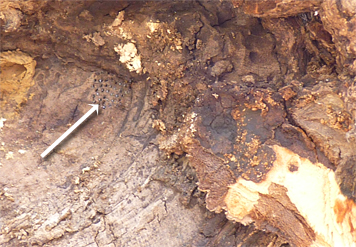Over the past few weeks I’ve seen several species of butterfly winging through the outdoor exhibits. Two of those species are very similar in appearance and both, if you’re hearing them for the first time, have rather odd names, Question Mark and Eastern Comma. Even their Latin names reflect the strangeness of the common names, Polygonia interrogationis and Polygonia comma respectively.



How did these butterflies get the names Question Mark and Comma? The underside of the hindwing tells the story.
Both Question Mark and Eastern Comma wear their names on their wings.

There are other ways to differentiate the two look-alikes such as their overall size and the shape of the wing edges, but the black spots are all you really need for identification if you can get a look at the upper surface of the wings. And, the punctuation marks will help if you get to see the underside of the insect. Often times, the problem is that the butterflies don’t always land where you want them to, or they take flight before you can get close enough to have a look at them.
Beware, there are other species of comma butterflies, Green Comma and Hoary Comma. Luckily, you’re probably not going to encounter them at the Museum as they are more likely to be seen in the mountains or in other states.
A low, hanging branch on a maple in Catch the Wind prompted one of the staff to remove the limb for safety reasons. Where the limb had been attached to the tree was a gap, a crevice, which was wide enough for insects to crawl into, but not large enough for a bird to gain access. With the limb removed that gap was now exposed.
There were insect eggs attached to the wood on both the tree itself and the broken part of the limb.

The eggs were most probably laid the previous fall in what the insect that had deposited them had considered to be a safe place, deep inside a crevice in a tree. Now that the location was exposed, the eggs on the tree disappeared within a day or two. Birds are constantly searching the trunks and branches of trees for tasty snacks. I suspect a Carolina Chickadee, perhaps a Ruby-crowned Kinglet, or maybe a White-breasted Nuthatch was the lucky finder the eggs.

Fortunately, the branch was placed into the woods with the ripped and torn wood facing downward. The eggs were protected from the watchful eyes of would-be predators.
When first seeing the eggs I thought they were the work of a large moth. But moth eggs are usually round or oval shaped. It wasn’t until I viewed photographs of the eggs later that I realized that the eggs were more barrel-shaped with a crown-like structure at the top edge, like the eggs of an assassin bug, or a stink bug (I saw a stink bug on the same tree a day or two later). I had thought, though, that stink bugs laid their eggs on leaves, which are scare in winter. The truth is I don’t know if the eggs were laid last fall or this year, although I suspect last fall.

I now have the eggs in a container in my office to both protect them from predation and, more honestly, to see what hatches from them. Hopefully that won’t be too long. When insect eggs begin to turn color, as these eggs appear to be doing, whatever is inside is getting ready to come out.
I will keep you posted.
Thank you for the page which shows how to tell the comma from question mark butteflies from the top.
Dave,
Thanks for commenting, and you’re welcome.
What a wonderful post, exclamation mark
Thanks Wendy!